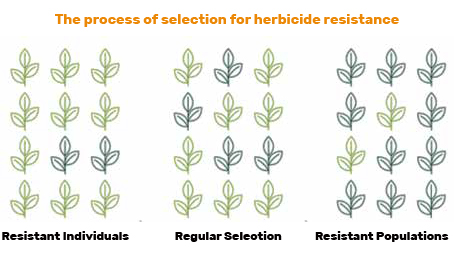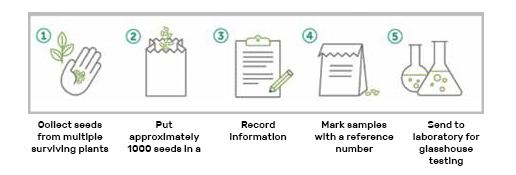Best Management Practices
Use these tools to assess the risk of developing herbicide-resistant weeds and to manage fields with resistant weed populations. By bringing diverse crop management techniques to their farms, growers can mitigate the development and spread of herbicide-resistant weeds.
Weed populations typically have a wide range of genetic variability. A small number of plants in any weed populations may include genetic traits that are resistant to specific herbicides. When a herbicide is applied, most of the susceptible plants are controlled, but resistant plants continue to grow. If allowed to set seed, these resistant weeds could grow and set seed the next year if the same herbicide was used.

With continued application of the same herbicide, eventually susceptible plants would be killed, resistant plants would be selected for and the weed population would be dominated by resistant plants.
Resistance risk assessment
For farmers to assess the risk of developing herbicide resistance, they need to evaluate their farming practices as well as the biology and herbicide susceptibility of their target weeds. The table below provides a checklist of resistance risk factors and can rank the risk of resistance development from LOW to HIGH.
Cropping System Evaluation - Risk of Resistance
| MANAGEMENT OPTION | LOW RISK | MODERATE RISK | HIGH RISK |
| Herbicide mix or rotation in cropping system | >2 modes of action | 2 modes of action | 1 mode of action |
| Weed control in cropping system | Cultural*, mechanical and chemical | Cultural and chemical | Chemical only |
| Use of same mode of action per season | Once | More than once | Many times |
| Cropping system | Full rotation | Limited rotation | No rotation |
| Resistance status to mode of action | Unknown | Limited | Common |
| Weed infestation | Low | Moderate | High |
| Control in last three years | Good | Declining | Poor |
Farming practices that increase the risk of resistance:
- Frequent use of herbicides with a similar mechanism of action – this is the most important of all factors
- Monocultures and crop rotations that rely on the same herbicide mechanism of action for weed control • Lack of non-chemical weed control practices such as cultivation, stubble burning, stale seedbeds and competitive and cover crops
Weed biology:
- Density of weeds – more weeds means a higher chance of resistance
- Frequency of resistance in the population – greater genetic diversity means a higher chance of resistance
- Reproductive capacity – weeds that produce a high number of seeds can spread resistance more quickly.
Substandard weed control
If a farmer does not achieve expected weed control levels that does not mean resistance is an issue. Analysis of herbicide use, rates, weed type and growth stage, climatic conditions and agronomic practices should be reviewed.
Following a thorough investigation, if resistance is still suspected, review the field history and the following questions:
- Has the same herbicide or herbicides with the same mechanism of action been used for several years?
- Has the uncontrolled weed been successfully controlled by the same herbicide in previous years?
- Are there live weeds beside dead weeds of the same species following a herbicide application?
- Has a decline in control been noticed in recent years?
- Are there resistant weeds in local fields, roadsides, farms, etc.?
- Are other species in the same location being adequately controlled by your herbicide application?
With a number of ‘yes’ answers and other factors ruled out, resistance may be strongly suspected. At this point, leave a small area of weeds to collect whole plant or seed samples to test so resistance can be determined.
Seed sample from suspect plant

Integrated Weed Management
Integrated Weed Management (IWM) refers to using chemical, cultural, mechanical and biological methods, in an integrated fashion, to control weeds. It does not rely excessively on any one method. When used in a integrated approach, the following tools help reduce selection pressure and survival of resistant weeds.
Chemical
Applying herbicides to a crop.
Mechanical
Includes measures such as hand-weeding using cultivation or ploughing to control emerged plants and bury non-germinated seed. It also includes harvest weed seed destruction such as stubble burning and cutting for hay or silage to prevent the weeds from setting seed.
Cultural
Includes altering the crop planting date, row spacing and harvest timing to disrupt the weed cycle. It also includes planting crops that can out-compete weeds, buying certified seed that’s free of weeds and using a diverse crop rotation. Growers should also sanitize farm equipment when moving between fields.
Biological
Includes introducing insects and pathogens that control target weed species and introducing post-harvest grazing of growing weeds.
Using a diversified crop rotation allows farmers to use these different weed techniques. Avoid successive crops that use herbicides with the same mechanism of action to control the same weed species in the same field.
Herbicide rotation and mixtures
When planning a weed control program, herbicides should be selected from groups that use different sites of action to control the same weed and used in successive applications or in mixtures. The global HRAC has developed a classification system for herbicides based on site of action that the herbicide uses.
Guidelines for the sustainable use of herbicide site of action groups:
- Use mixtures or sequential treatments of herbicides having different sites of action. Each herbicide in the mixture should target the same weed species.
- Consider all chemical control options before planting, in-crop and after harvest.
- Avoid continued use of the same herbicides, or herbicides with the same site of action in the same field, unless integrated with other weed control practices.
- Limit the number of applications of a single herbicide or herbicides with the same site of action in a single growing season.
- Herbicide mixtures and herbicide rotations alone are not enough to prevent resistance. They must be used in a diversified plan than also incorporates mechanical, cultural and biological practices.
Growers should also do the following:
- Follow label use instructions, such as application rates, timing and equipment recommendations.
- Know the weeds in their fields and nearby non-crop areas and tailor their weed control program to weed densities and economic thresholds.
- Monitor herbicide results and be aware of any trends or changes in weed populations.
- Maintain detailed field records to confirm cropping and herbicide history.
What to do when resistance is confirmed
When a control failure is confirmed as resistance, immediate action is required to remove any surviving weeds and limit seed production. Action depends on the crop stage and extent of the problem.